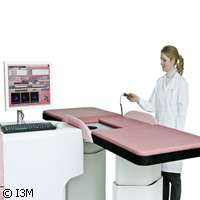Innovative device offers earlier breast-cancer detection

A team of EU-funded researchers has developed a new type of mammogram technique using molecular imaging which could help detect breast cancer earlier.
The technique was researched as part of the MAMMI (Mammography with molecular imaging) project which received EUR 2.5 million in funding under the 'Life sciences, genomics and biotechnology for health' Thematic area of the Sixth Framework Programme (FP6).
Led by the Spanish National Research Council (CSIC), the pan-European team was made up of scientists from eight institutions from Germany, the Netherlands, Portugal and Sweden.
Specially designed to detect breast cancer in its earliest stages, the MAMMI device offers the highest resolution and sensitivity currently available. This means it will be used mostly for early breast cancer diagnosis and evaluating how patients respond to chemotherapy.
To capture an image with the device, the patient lies face down on a specially designed table and puts a breast in one of the openings. Beside the table, the specialist operating the device positions a trolley incorporating the detection system based on a gamma ray sensor. Thanks to the ring shape of the detector that surrounds the pendant shape of the breast, there is no need to compress the breast. Dr. José María Benlloch from the CSIC explains how this significantly enhances 'visualisation and diagnosis', as tumours are sometimes 'very close to the base of the pectoral muscle'.
In the early stages of a cancer, the malignant cells replicate in an uncontrolled way and after a few years can cause a lesion to appear that is visible with the current techniques. After that, the lesion extends and takes about another year until it can be felt.
Current diagnostic practises and traditional mammograms are based on morphological images, and consequently don't recognise the cancer until there is a lesion; in contrast, an X-ray of mammary glands taken with the MAMMI device is based on the positron emission tomography (PET) technique for the diagnosis of breast cancer, which offers an array of benefits. The PET technique in the MAMMI device measures the metabolic activity of the tumour by locating the high glucose uptake of the cancer cells.
This allows specialists to detect the disease much earlier, a development that will be welcomed by those affected; the existing body of research confirms that early diagnosis reduces mortality by 29%.
Although whole-body PET scans are currently used, for the most part these are reserved for those already diagnosed with breast cancer or for people with a high risk of suffering from the disease, and even then the result is a low-resolution image that does not reveal small tumours. The MAMMI device, however, focuses solely on the breasts so the detectors are in very close proximity to them, and can identify tumours in their very early stages.
The MAMMI device can see lesions as small as 1.5 mm, compared to the 5 mm limit of current machinery. Therefore, while improving diagnosis in all patients, the technique can be particularly effective for women with breast implants or women whose breast density makes obtaining a clear image difficult. The MAMMI device has also proved to provide greater patient comfort, which means it will be particularly useful for treating the elderly and the disabled.
Hospitals and treatment centres all over the world have shown an interest in purchasing the device. Currently, it is being used in Amsterdam's National Cancer Institute in the Netherlands. It has also done a stint at the Technical University of Munich in Germany and it will soon be installed in the Provincial Hospital of Castellon in Spain as well.
The mammography device can also monitor whether a breast cancer patient's treatment is actually working. It does this by showing the uptake of glucose, and revealing whether there are still cancer tissues after an operation. With existing techniques, it is impossible to distinguish tumor tissue from the scar left by the operation. This new type of therapy can also show whether radiation and chemotherapy levels are effective or need to be modified.















